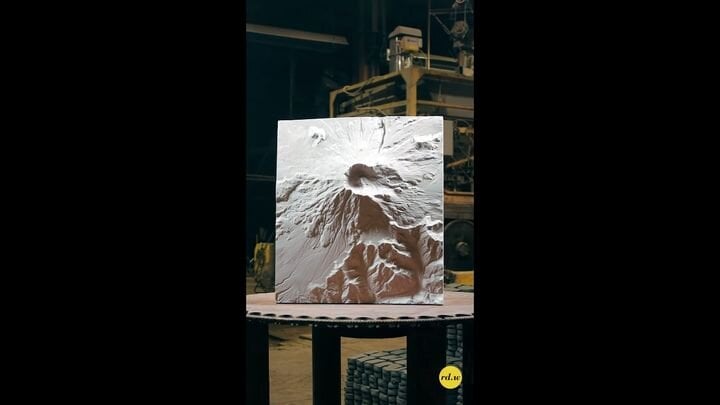![CNC-produced 3D model of Mt. St. Helens [Source: SolidSmack]](https://fabbaloo.com/wp-content/uploads/2020/05/image-asset_img_5eb08c291e644.jpg)
Most craftsmen think of CNC machining as a means to an end, but for the filmmaker and digital artist Dom Riccobene, it’s the best way to make miniature landscapes of both real-world and fictional locales.
We’ve already seen his AR map of Game of Thrones’ Westeros, but this time around, he’s gone back to the real world to create a giant data sculpture of Washington’s Mount St. Helens:
Using a model of the volcano from Google Earth VR, Dom completes two test carves on some high-density urethane (HDU) to see what ball end he will use for his final result.
![Rough cut of the CNC-produced 3D model of Mt. St. Helens [Source: SolidSmack]](https://fabbaloo.com/wp-content/uploads/2020/05/image-asset_img_5eb08c295e02b.jpg)
After deciding on sixteen-inch tooling, he sets the CNC machine to go at a half-inch flat-end mill at 800 inches per minute with a 1/8 inch down for the rough pass. While he could go a half-inch step down to make the process faster, he keeps it so for recording purposes. Thanks to this, you can slowly see the volcano emerge from the urethane as the machine works downwards.
As the carving continues, more of the surrounding topography begins to emerge. What was once only the tip of the crater now has ridges and layers surrounding it.
Satisfied with the roughing pass, Dom then completes a finishing pass to fine-tune the carving. In total, it takes 1,800,000 lines of G-code to produce this miniature recreation of Mt. Saint Helens, making the finished product incredibly dense and detailed as a result.
![Final version of a CNC-produced 3D model of Mt. St. Helens [Source: SolidSmack]](https://fabbaloo.com/wp-content/uploads/2020/05/mt.-saint-helens-cnc-machined-final_img_5eb08c299e98a.jpg)
Eventually, the various ridges which signify the different layers of the volcano are cut to reveal the many rivers, cracks, and crevices dotting the landscape.
Read the Rest at SolidSmack

